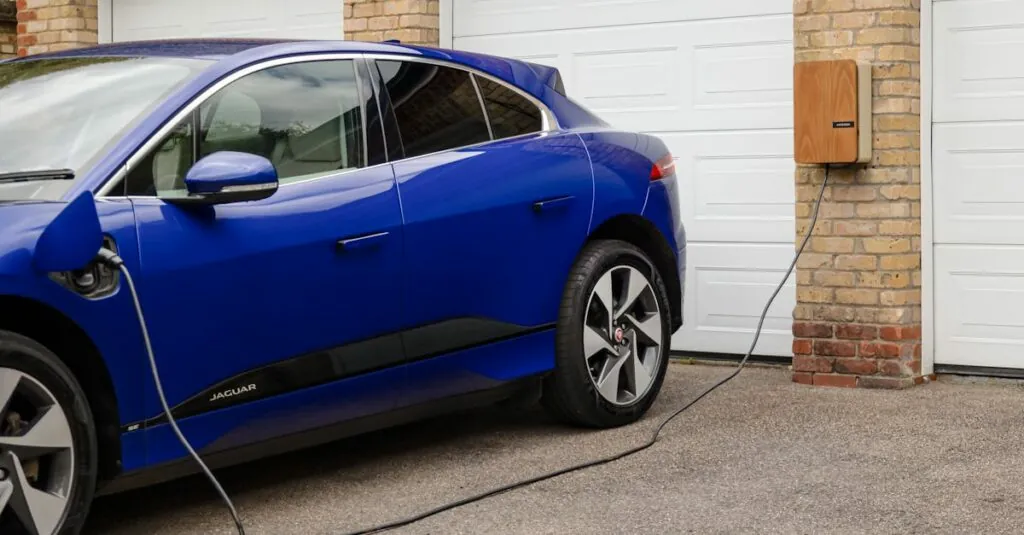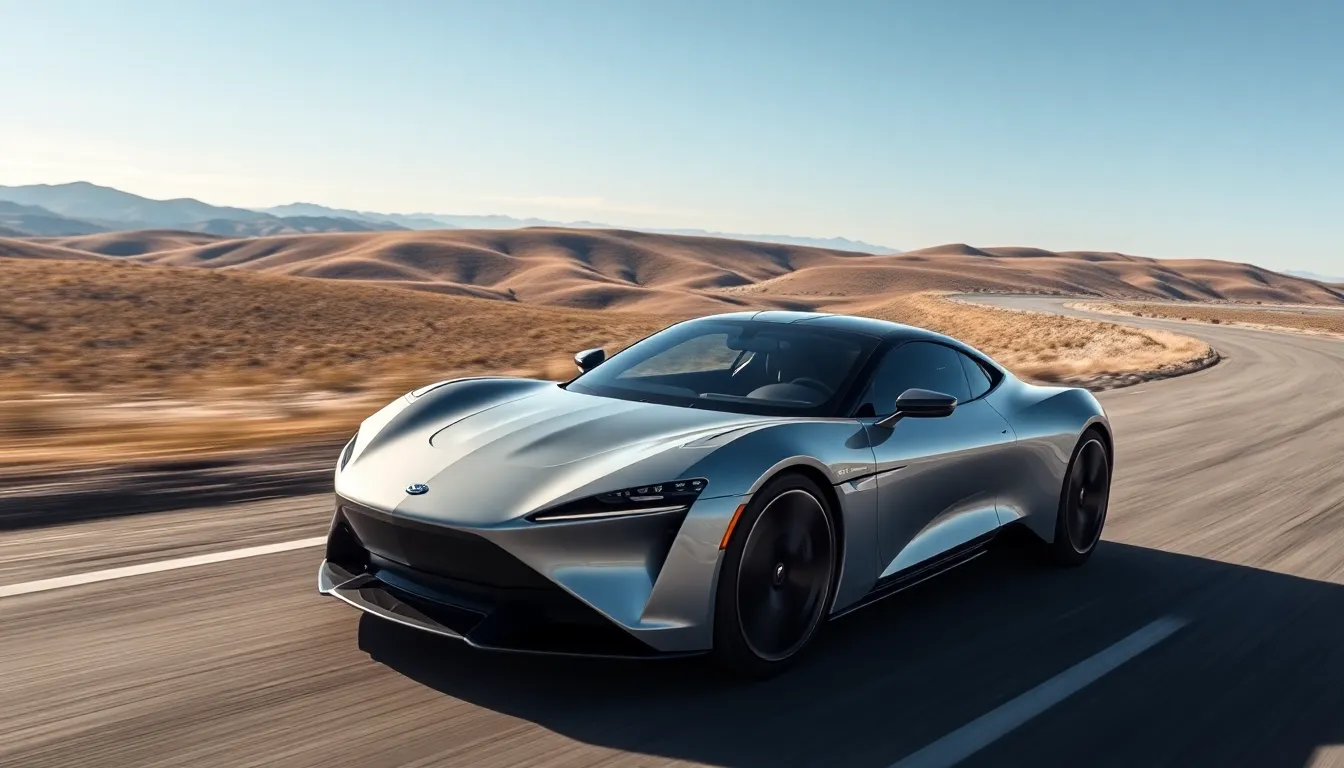In a world where traffic jams are as common as coffee breaks, eco-friendly driving habits might just save the planet—and your sanity. Imagine cruising down the highway, windows down, while your car hums along like a well-tuned orchestra. It’s not just about saving the Earth; it’s about saving your wallet too. Who doesn’t want to spend less on gas and more on that fancy avocado toast?
Table of Contents
ToggleUnderstanding Eco-Friendly Driving Habits
Eco-friendly driving habits encompass practices that promote sustainable vehicle operation, reduce emissions, and enhance fuel efficiency. Such habits not only contribute to a greener environment but also lead to cost savings.
Definition of Eco-Friendly Driving
Eco-friendly driving refers to techniques centered on minimizing fuel consumption and lowering harmful emissions. Implementing smoother acceleration and deceleration assists in achieving better fuel efficiency. Maintaining optimal tire pressure ensures vehicles operate efficiently, while avoiding excessive idling further reduces waste. Carpooling, using public transport, or driving fuel-efficient vehicles also qualify as eco-friendly practices, significantly impacting overall carbon footprints.
Importance of Eco-Friendly Driving
Adopting eco-friendly driving habits yields profound benefits for both individuals and the environment. Fuel savings can reach 10 to 30 percent through improved driving practices. Reducing emissions enhances air quality, positively affecting public health. Additionally, these habits decrease dependence on fossil fuels, paving the way for sustainable energy sources. The collective impact of eco-friendly driving can lead to a significant reduction in greenhouse gas emissions, contributing to global climate goals and promoting environmental sustainability.
Key Eco-Friendly Driving Techniques
These techniques contribute to improved fuel efficiency and reduced emissions. Implementing them enables a smoother driving experience while benefiting the environment.
Maintaining Steady Speed
Driving at a consistent speed enhances fuel economy. Frequent acceleration and braking increase fuel consumption significantly. Keeping a steady speed allows the engine to operate efficiently, resulting in fuel savings. Research indicates that maintaining a speed between 45 and 65 mph optimizes fuel efficiency. Using higher gears when possible helps reduce engine strain and fuel use. This practice also minimizes wear on the vehicle, prolonging its lifespan.
Reducing Idling Time
Reducing idle time supports better fuel efficiency and lowers emissions. Engines consume fuel even when not in motion, leading to unnecessary waste. Turning off the engine during long stops saves fuel and decreases harmful emissions. Shortening idle periods contributes to improved air quality, making it a win for the driver and the environment. For instances of idling longer than 10 seconds, shutting off the engine proves more efficient. Implementing this habit can lead to a noticeable decrease in fuel expenses over time.
Utilizing Cruise Control
Employing cruise control simplifies maintaining a constant speed. This function reduces the need for frequent acceleration, which helps conserve fuel. On open highways, using cruise control can lead to fuel savings of up to 15 percent. Adjusting speed smoothly contributes to a more efficient drive, minimizing fuel consumption. Proper use of cruise control enhances overall driving comfort while supporting eco-friendly goals. This technique proves beneficial in preventing unintentional speeding, which often results in higher fuel use.
Vehicle Maintenance for Eco-Friendly Driving
Maintaining a vehicle regularly supports eco-friendly driving. Simple actions can enhance fuel efficiency and reduce emissions, contributing to a healthier environment.
Regular Tune-Ups
Regular tune-ups enhance vehicle performance and efficiency. Engines operate optimally when spark plugs, air filters, and fuel injectors are clean. Schedule tune-ups every 5,000 to 10,000 miles, depending on the vehicle. Following this practice can improve fuel economy by up to 20 percent. Additionally, addressing engine issues promptly can prevent further damage and maintain lower emissions, aligning with eco-friendly goals.
Proper Tire Inflation
Proper tire inflation plays a crucial role in fuel efficiency. Tires should be inflated to the manufacturer’s recommended pressure, typically found on the door jamb or in the owner’s manual. Monthly checks help maintain optimal inflation, improving fuel economy by about 3 percent. Under-inflated tires increase rolling resistance, causing engines to work harder and consume more fuel. Regularly maintaining tire pressure not only saves fuel but also ensures safer driving conditions.
Using the Right Engine Oil
Using the right engine oil is essential for maximizing vehicle efficiency. Manufacturers specify oil types that work best for their engines; choosing the correct viscosity and complying with specifications is vital. Using the recommended oil can improve fuel economy by 1 to 2 percent. Additionally, synthetic oils reduce engine friction and enhance performance, contributing to lower emissions. Following these guidelines supports an eco-friendly driving experience while prolonging engine life.
The Role of Technology in Eco-Friendly Driving
Technology plays a significant part in promoting eco-friendly driving habits. By integrating advanced features into vehicles, manufacturers enhance fuel efficiency and reduce emissions.
Fuel-Efficient Cars
Fuel-efficient cars now leverage innovative engine designs and lightweight materials. Manufacturers utilize turbocharged engines that provide better power and efficiency, often achieving 30 percent more fuel economy than traditional models. Features like start-stop technology also enable engines to turn off during idling, further conserving fuel. Additionally, automatic transmission systems adjust gear shifts for optimal performance under varying driving conditions, maximizing efficiency. These advancements not only lower fuel consumption but also contribute to decreased greenhouse gas emissions, making them vital in the pursuit of a greener future.
Hybrid and Electric Vehicles
Hybrid and electric vehicles set new standards for eco-friendly driving. Hybrids combine gasoline engines with electric motors, reducing fuel consumption and emissions significantly. Many hybrids achieve up to 50 miles per gallon, greatly surpassing conventional options. Electric vehicles rely entirely on battery power, producing zero tailpipe emissions. Rapid advancements in battery technology allow these vehicles to travel greater distances, making them increasingly practical. With incentives and improved charging infrastructure, the transition to hybrids and electric vehicles promotes sustainable transportation and further supports eco-friendly driving habits.
Lifestyle Changes to Support Eco-Friendly Driving
Adopting eco-friendly driving habits involves making simple lifestyle changes that enhance sustainable practices.
Carpooling and Ridesharing
Carpooling significantly reduces individual carbon footprints. Individuals share rides to destination, leading to fewer vehicles on the road. Statistics reveal that one carpool can decrease emissions by an average of 1,300 pounds per year per person. Ridesharing services complement this by connecting drivers with passengers, promoting shared journeys. Utilizing these options not only minimizes travel costs but also fosters community interaction.
Public Transportation Options
Public transportation options offer efficient alternatives to driving alone. Buses, trains, and subways frequently operate on existing routes, reducing the number of personal vehicles. For instance, a full bus can replace approximately 50 cars, significantly lessening traffic congestion and emissions. Utilizing these services contributes to a sustainable lifestyle while decreasing reliance on fossil fuels. Many cities provide discounts for public transit, making it an economical choice.
Combining Errands to Reduce Trips
Combining errands effectively reduces the number of trips taken in a vehicle. Individuals group tasks, such as grocery shopping and appointments, into one journey, saving time and fuel. Studies show that planning routes can cut travel distances by up to 25 percent. This approach not only lowers emissions but also saves on fuel expenses. Combining errands streamlines busy schedules while fostering a commitment to eco-friendly choices.
Adopting eco-friendly driving habits is a powerful way to contribute to a healthier planet while benefiting personally. By implementing simple techniques like maintaining a steady speed and reducing idling, drivers can significantly cut fuel costs and emissions. Regular vehicle maintenance further enhances efficiency and extends the life of the vehicle.
Embracing technology and lifestyle changes also plays a crucial role in promoting sustainability. Whether through carpooling or opting for hybrid and electric vehicles, every choice counts. Collectively, these actions foster a greener environment and support the global effort to combat climate change. By making conscious decisions on the road, individuals can drive towards a more sustainable future.





